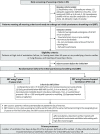T-piece versus pressure-support ventilation for spontaneous breathing trials before extubation in patients at high risk of reintubation: protocol for a multicentre, randomised controlled trial (TIP-EX)
- PMID: 33234658
- PMCID: PMC7689072
- DOI: 10.1136/bmjopen-2020-042619
T-piece versus pressure-support ventilation for spontaneous breathing trials before extubation in patients at high risk of reintubation: protocol for a multicentre, randomised controlled trial (TIP-EX)
Abstract
Introduction: In intensive care unit (ICU), the decision of extubation is a critical time because mortality is particularly high in case of reintubation. To reduce that risk, guidelines recommend to systematically perform a spontaneous breathing trial (SBT) before extubation in order to mimic the postextubation physiological conditions. SBT is usually performed with a T-piece disconnecting the patient from the ventilator or with low levels of pressure-support ventilation (PSV). However, work of breathing is lower during PSV than during T-piece. Consequently, while PSV trial may hasten extubation, it may also increase the risk of reintubation. We hypothesise that, compared with T-piece, SBT performed using PSV may hasten extubation without increasing the risk of reintubation.
Methods and analysis: This study is an investigator-initiated, multicentre randomised controlled trial comparing T-piece vs PSV for SBTs in patients at high risk of reintubation in ICUs. Nine hundred patients will be randomised with a 1:1 ratio in two groups according to the type of SBT. The primary outcome is the number of ventilator-free days at day 28, defined as the number of days alive and without invasive mechanical ventilation between the initial SBT (day 1) and day 28. Secondary outcomes include the number of days between the initial SBT and the first extubation attempt, weaning difficulty, the number of patients extubated after the initial SBT and not reintubated within the following 72 hours, the number of patients extubated within the 7 days following the initial SBT, the number of patients reintubated within the 7 days following extubation, in-ICU length of stay and mortality in ICU, at day 28 and at day 90.
Ethics and dissemination: The study has been approved by the central ethics committee 'Ile de France V' (2019-A02151-56) and patients will be included after informed consent. The results will be submitted for publication in peer-reviewed journals.
Trial registration number: NCT04227639.
Keywords: adult intensive & critical care; respiratory medicine (see thoracic medicine); respiratory physiology.
© Author(s) (or their employer(s)) 2020. Re-use permitted under CC BY-NC. No commercial re-use. See rights and permissions. Published by BMJ.
Conflict of interest statement
Competing interests: AWT reports financial support (payment for lectures and travel expenses coverage to attend scientific meetings) by Fisher & Paykel, Covidien, Maquet—Getinge, GE Healthcare. J-PF reports consulting fees from Fisher & Paykel and SOS oxygène.
Figures
References
-
- Schmidt GA, Girard TD, Kress JP, et al. . Official executive summary of an American thoracic Society/American College of chest physicians clinical practice guideline: liberation from mechanical ventilation in critically ill adults. Am J Respir Crit Care Med 2017;195:115–9. 10.1164/rccm.201610-2076ST - DOI - PubMed
Publication types
MeSH terms
Associated data
LinkOut - more resources
Full Text Sources
Medical

